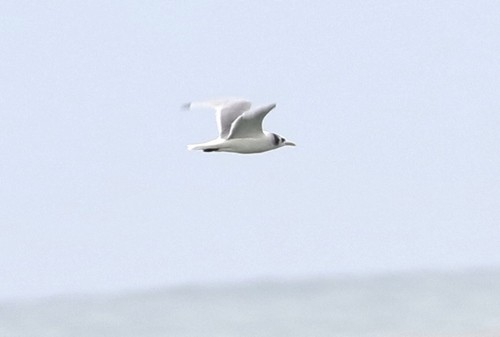Black-legged Kittiwake
A species of Kittiwakes Scientific name : Rissa tridactyla Genus : Kittiwakes
Black-legged Kittiwake, A species of Kittiwakes
Botanical name: Rissa tridactyla
Genus: Kittiwakes
Content
Description People often ask General Info
 Photo By silversea_starsong , used under CC-BY-NC-4.0 /Cropped and compressed from original
Photo By silversea_starsong , used under CC-BY-NC-4.0 /Cropped and compressed from original Description
The black-legged kittiwake (Rissa tridactyla) is a seabird species in the gull family Laridae. This species was first described by Carl Linnaeus in his landmark 1758 10th edition of Systema Naturae as Larus tridactylus. The English name is derived from its call, a shrill 'kittee-wa-aaake, kitte-wa-aaake'. The genus name Rissa is from the Icelandic name rita for this bird, and the specific tridactyla is from Ancient Greek tridaktulos, "three-toed", from tri-, "three-" and daktulos, "toe". In North America, this species is known as the black-legged kittiwake to differentiate it from the red-legged kittiwake, but in Europe, where it is the only member of the genus, it is often known just as kittiwake. 
Size
41 - 43 cm
Colors
Gray
White
Life Expectancy
21 years
Nest Placement
Cliff
Clutch Size
1 - 3 eggs
Feeding Habits
Black-legged Kittiwake's diet consists mainly of small fish and invertebrates such as squid, euphausiids, amphipods, copepods, polychaetes, and jellyfish, which it catches from the surface or below by dipping, plunging, or chasing underwater. They forage by following whales or boats, often in mixed-species flocks, and practice kleptoparasitism. Fish consumed varies by region, e.g., sandeels in the UK. Black-legged Kittiwake forages day and night, avoids scavenging on land, and prefers saltwater.
Habitat
Black-legged Kittiwake resides mainly in marine environs, favoring coastal cliffs and island edges in temperate to polar zones. Their nesting sites are characteristically sparse in vegetation and located on steep cliffs or structures, facilitating ocean prey access. They adapt across altitudes near these coastal regions, and outside breeding season, they disperse to icy edges and warmer sea regions, seldom visiting land.
Nest Behavior
Black-legged Kittiwake nest building is a joint effort. They lay eggs timed with food abundance, engaging in biparental care to incubate eggs and raise the young, with precise timing and coordination between the parents.
Nest Characteristics
Black-legged Kittiwake typically select narrow ledges on sea cliffs or occasionally human-made structures, sharing space with auks. Their nests, bowl-shaped and constructed from mud, grass, and marine vegetation, sometimes feathers, average 17.7 inches in diameter with a 9.8-inch inner cup.
Dite type
Piscivorous
People often ask
General Info
Feeding Habits
Bird food type
Behavior
Black-legged Kittiwake are known for their social and synchronized nesting habits, typically returning to the same cliffs each spring. Males arrive first, reasserting claims on nesting sites and initiating courtship through a distinctive 'choking' display. Pair bonds are strong, often reuniting mates annually, and engagements involve head-nodding and neck-crossing. They exhibit monogamous pairing, with low rates of extrapair paternity. Both partners partake in nurturing offspring by incubating eggs and feeding chicks after a ritual of begging for food by females. Once the breeding season concludes, black-legged Kittiwake disperse oceanward, signaling completion of their reproductive duties.
Distribution Area
The black-legged kittiwake is a coastal bird of the arctic to subarctic regions of the world. It can be found all across the northern coasts of the Atlantic, from Canada to Greenland as well as on the Pacific side from Alaska to the coast of Siberia. Black-legged kittiwakes' wintering range extends further south from the St-Lawrence to the southern coast of New Jersey as well as in China, the Sargasso sea and of the coast of west Africa. There are two subspecies of black-legged kittiwake. Rissa tridactyla tridactyla can be found on the Atlantic coast whereas Rissa tridactyla pollicaris is found on the Pacific coast. Out of all the laridae, the kittiwakes are the most pelagic ones. Kittiwakes are almost exclusively found at sea with the exception of the breeding period, from May to September, where they can be found nesting on the sheerest sea cliffs. They are rarely found inland, though they have been reported on few instances as far as 20 km inland. For the rest of the year, kittiwake spend most of their time on the wing out of sight from the coast. 
Species Status
There are still no global conservation plans for the black-legged kittiwake though the species is closely monitored for population trends shifts. There are currently no international legislations regarding this species. However, the black-legged kittiwake is protected under the Migratory Bird Treaty Act of 1918 that has been ratified by the US, Canada, Mexico, Russia and Japan. As for many gull species, the kittiwake is not a species of special interest for the public, therefore there are no education plans put in place in order to inform and educate people regarding this species. 
Scientific Classification
Phylum
Chordates Class
Birds Order
Shorebirds Family
Gulls Genus
Kittiwakes Species
Black-legged Kittiwake